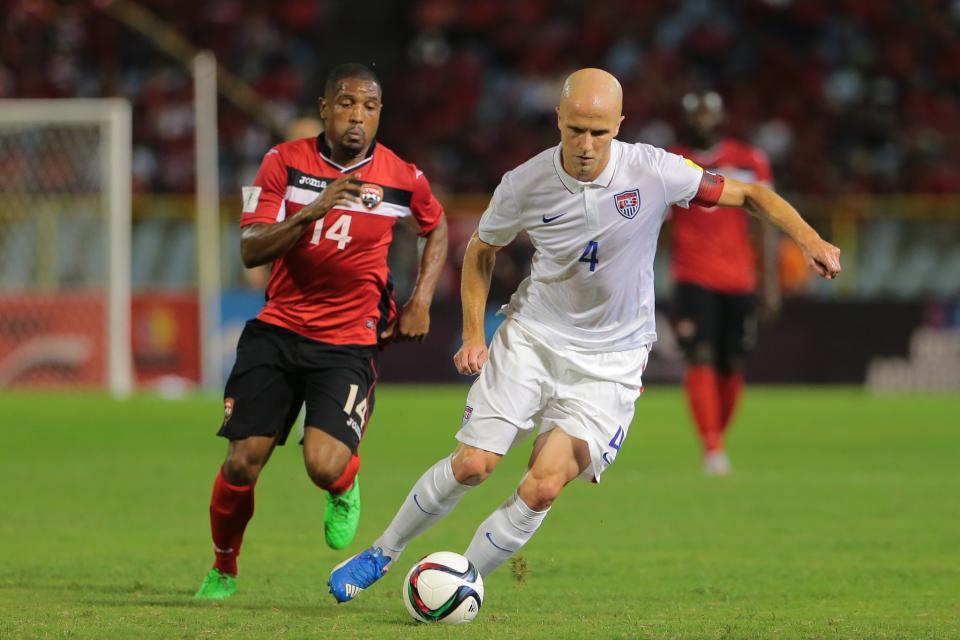USMNT faces T&T with almost nothing at stake but plenty to gain

This is essentially a formality. Because the situation is basically as follows: The United States men’s national team plays Trinidad and Tobago on the last day of the fourth phase of CONCACAF qualifying for the 2018 World Cup on Tuesday and all the Yanks really need to advance to the final round is to not lose by six or so goals.
[ Live updates: USMNT vs. Trinidad and Tobago in World Cup qualifying (8 p.m. ET on FS1) ]
Through five games, the USA has 10 points in Group C. T&T has 11 and has already qualified. The top two teams advance, but the Americans have a three-point lead on third-place Guatemala, which play last-place and points-less St. Vincent and the Grenadines, whom the U.S. beat 6-0 on Friday. Should Guatemala win and the U.S. lose, however, the first tie-breaker would be goal difference. And on that score, the Americans lead by 12 goals.
Which is to say if Guatemala managed, say, a 7-0 rout of the Vincy Heat at home – they won the away game 4-0 – the U.S. would still have to lose 5-0. Now consider that in 22 all-time meetings with T&T, the Americans have lost just twice. Both times by a single goal. And both times in Trinidad, and not on American soil, like Tuesday’s game in Jacksonville, Fla. In those 22 games, the USA has given up just 10 goals total, or an average of 0.45 per game. And before the teams’ first meeting in these qualifiers, a dour 0-0 stalemate in Port of Spain, the U.S. had won 10 of their last 12 matches.
So, yes, while participation at the 2018 Russia is technically at stake, it’s all kind of been decided already. There’s little left to play for, other than the avoidance of a catastrophic and humiliating loss.
The only real consideration is that the winner of the group – which would be the Americans if they beat Trinidad, while a tie retains the status quo – plays Mexico at home in its first game in the final round of qualifying in November, and then likely Costa Rica away. That’s a harsh way to start the double round-robin between the final six teams of the region, three of whom will qualify for the World Cup directly and the fourth of which will go to a playoff. But then U.S. head coach Jurgen Klinsmann has said that he would welcome such an opening, as he likes getting the tougher games out of the way early. And because it would give the USA a chance to take Mexico somewhere cold in November, making the guests as uncomfortable as they do the Yanks at the daunting Estadio Azteca in Mexico City.
As such, the question becomes what the best use of this a game is to the Americans. While it’s a dead rubber in a competitive sense, with hardly any consequences, it’s still a real World Cup qualifier against one of the region’s wiliest teams.
There are two ways of approaching it: start your best possible team, just to be safe. On the off chance that something very odd might happen otherwise and two decades of national team progress might be threatened – after all, if Guatemala somehow ends up above the USA, there’s no World Cup.
Or Klinsmann might seize the opportunity to use an all-but-sure thing to hand some more minutes to all the young players he called up for just such a scenario: a no-pressure second game. He has complained at length that the national team prospects have made little progress in displacing the veterans, either struggling to find their feet on the club scene or simply not doing enough to wrest jobs from the incumbents.
Tuesday’s game could be a showcase for those players as the hexagonal round looms and qualifying gets serious in two months. While 21-year-old Molde goalkeeper Ethan Horvath will not be starting, since the games were promised to the veteran platoon of Tim Howard and Brad Guzan, others might. Kellyn Acosta, 21, might get another run at left back while Steve Birnbaum, 25, could cement his good earlier impression in central defense.
Caleb Stanko, 23, could make his debut in central midfield. He might be joined by Christian Pulisic (the 17-year-old who has dazzled by scoring three times in his first seven appearances), Paul Arriola, 21, and late-bloomer Darlington Nagbe, 26. Up front, perhaps Jordan Morris, 21, and Rubio Rubin, 20, will get another crack. But then habitual starter Bobby Wood is only 23 himself.
The point of qualifying is two-fold: the first, plainly, is to get yourself to the big tournament. The other is to get ready for it. And given the preponderance of veterans still playing major roles, and the fact that plenty of them, like Clint Dempsey and Jermaine Jones, will be in their mid-30s by the time the next World Cup begins, there’s a lot to be said for going young.
And in so doing, to inject some meaning into an otherwise practically meaningless game.
Leander Schaerlaeckens is a soccer columnist for Yahoo Sports. Follow him on Twitter @LeanderAlphabet.



